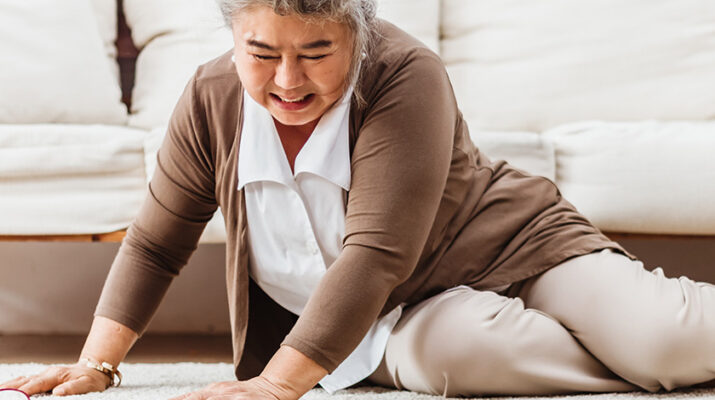Experts provide tips on how not to be part of this group
By Deborah Jeanne Sergeant
According to the Centers for Disease Control and Prevention, 28% of Americans 65-plus will fall this year.
The National Institutes of health reports, “Falls in older adults are a common occurrence and may lead to serious injuries [like head injury and fractures]. Recurrent falls are also frequent and are responsible for significant morbidity and mortality in older adults.”
The consequences of falling are great for people who cannot rise and lie on the floor injured for hours or even days. What often happens after a fall and serious injury is that older adults remain less active because they’re recovering from the fall. Or they choose to reduce their activity level because they fear another fall injury.
Reducing activity level also leads to greater dependence upon others for activities of daily living. Ideally, preventing falls is better than trying to introduce fall reduction measures after a fall has occurred. This can — and should — begin much earlier than when a person begins to have balance and strength issues limiting mobility and contributing to falls.
“When people are younger, they want to look good and have the six-pack abs. But as we get older, how we feel and how strong we are and how well we function and can we do what we need and want to do becomes incredibly valuable,” said Joe Fox, personal trainer, certified functional strength training coach and owner of TrainSMART Personal Training in Buffalo.
Starting early and remaining active can help prevent falls as one ages. Any exercise can benefit the body. However, exercising to avoid falls includes a few different aspects of fitness. Maintaining muscle mass can help people stay on their feet by allowing them to catch themselves before a fall. Staying agile and with good balance can help in this aspect as well. In case of a fall, those who exercise will likely avoid serious injury.
“Specifically, load-bearing exercises or resistance training or lifting weights stimulates bone density growth,” Fox said. “But just as important as building bone is actually changing the shape of bone. It’s my understanding that the trabecular column when the muscular skeletal system is strategically and safely loaded, you build bone and change the shape of bone in a way that’s beneficial for preventing injury when falling.”
If fitness has been on the back burner for a while, it’s important to ask a physician for clearance before embarking on a new routine.
Other factors can increase the risk of falls, especially with age-related changes. For some people, medication can cause dizziness, so asking the care provider about switching medications could spare a fall. Keeping eyeglasses clean and maintaining an up-to-date prescription can also reduce the risk of falls.
Shoes with medium to high heels, open backs, thick soles and ill fit can often contribute to falls.
Other environmental issues include wiping up spills promptly, keeping clutter picked up and avoiding stepladders.
An environmental assessment by a physical therapist can help people better understand how their “perfectly safe home” they’ve lived in 30 years may at this point of their lives be fraught with fall hazards.
Season Bonino, doctor of physical therapy and instructor at Nazareth University in Rochester, said that changes in vision often sneak up on people in their older years.
“A lot of times, there’s a small lamp in the corner of the living room,” she said. “That lack of lighting can lead to significant fall risk.”
Motion sensing lights can illuminate the pathway to the light switch. For homes with insufficient outlets, battery- operated and solar lights can help.
Throw rugs and bathmats are also common fall culprits because “as we get older, we aren’t picking our feet up as high,” Bonino said.
Taping the throw rug’s corners down may help, as can draping the bathmat over the tub when finished with it.
Handrails at home entrances and grab bars — not the suction cup kind — near the tub and toilet can also reduce falls. These should be installed by a pro and sturdy enough to support an adult’s weight. Towel bars are not enough.
Bonino warned about small furniture like coffee tables and ottomans close to the sofa.
Rather than forcing a shuffle to sit down, clear out these items.
The raised threshold between rooms or uneven flooring on a patio or porch can cause falls, as can stairs, since people don’t perceive the difference in height. Bonino recommends contrasting tape on steps to make these transitions easier to see.
Along with changes in vision, many people experience changes in balance as they age.
“If your balance is off a little, that can be the time to stop in and see a physical therapist or talk with your doctor before you have a fall,” Bonino said.
Patients in New York do not need a prescription or referral from a doctor to see a physical therapist for 10 visits or 30 days.
People of every age occasionally trip. However, older adults lose the ability to take that “fast step” and not completely wipe out.
“Our research is showing that we can be retrained,” Bonino said. “It takes about 45 minutes to significantly reduce fall risk based on validated fall measures.”
Her office uses a slip trainer device that uses a safety harness. No one actually falls, but it elicits a response to see how well they can try to prevent falling. This helps them relearn how to fast step and not fall.

